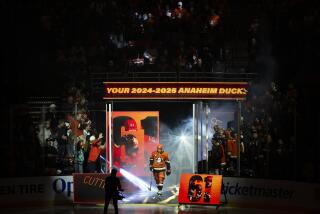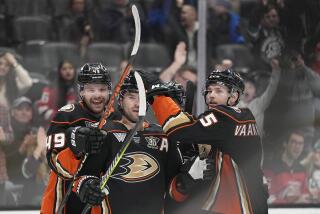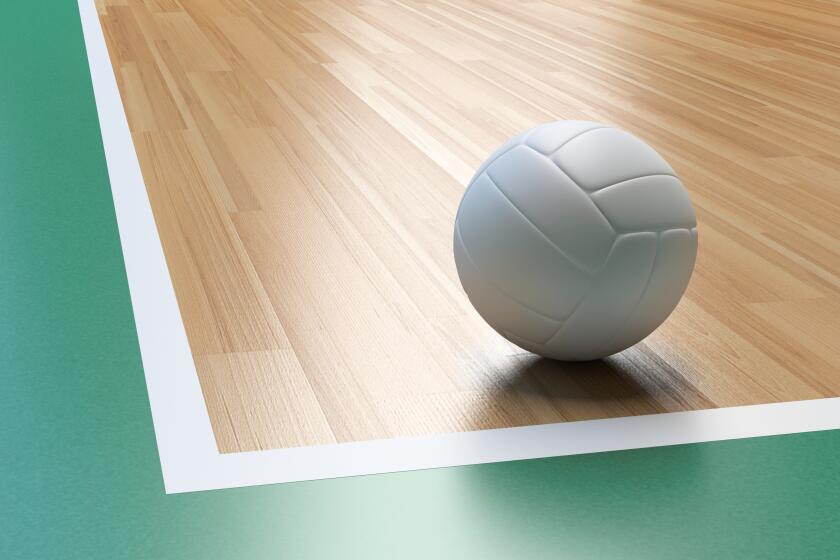Despite Profits, Duck Official Wants Cap : Hockey: Tavares says long-term financial success would be endangered by salary spiral.
The Angels cry poor, the Rams cry poor stadium. On the other side of the 57 Freeway, the Mighty Ducks made a bundle in their first NHL season.
“Hey, are we a small-market team?” General Manager Jack Ferreira says, his eyebrows arching with his joke. “The Angels say they are. I was just wondering.”
The Walt Disney Co.-owned NHL team made a seven-figure profit in its first season by selling out 98.9% of The Pond’s capacity, grabbing the largest share of the NHL’s $1-billion merchandise sales and scrimping by with the league’s lowest payroll, at $7.8 million.
So why is this team’s management supporting the NHL’s plan to impose a lockout unless a new agreement is reached with players before Saturday’s scheduled season openers?
The Ducks already have sold 12,500 season tickets, drawn a remarkable average of 16,576 for four exhibitions at The Pond, and have one of the league’s most promising rookies in Paul Kariya.
The Ducks have a state-of-the-art arena, a sweetheart of a lease and fans so loyal that they bought 22,000 single-game tickets the day after it was announced the season might be postponed.
“This franchise in particular would pay a very dear price for this one,” acknowledged club president Tony Tavares, who declined to reveal actual profit figures. “This is one of the years you expect to get back part of your investment. In the first two years, you expect to make more than a mature team, because your payroll is still below league average.”
But Tavares isn’t bucking the NHL’s hard-line approach. On the contrary.
“I think it basically comes down to a decision between short-term benefits and long-term benefits,” he said. “For every dollar in new revenue we’re generating, we’re spending much more than that in player salary increases. Hence, you don’t have to spend a lot of time analyzing it. You have an eroding bottom line.
“Unless we get that under control somehow, it leads you to the conclusion that financial disaster is right around the corner.”
Negotiators are trying to find common ground on several key issues, including a plan to help small-market teams--something players think should be the owners’ responsibility, not theirs--as well as changes in salary arbitration and free agency. In the most divisive issue, owners are seeking to link player salaries to revenues, and players are resisting any plan they believe is a salary cap.
The Ducks’ payroll has increased dramatically since last season--by as much as 60%, according to figures from the players’ association. Still, at about $12.6 million--a figure that is expected to increase somewhat--it still ranks 21st among 26 teams.
The payroll last season was artificially low because it was made up largely of unproven fringe players who were exposed to the expansion draft by other NHL teams. It increased this season with the signing of two first-round draft picks--Kariya, who is to make $2.8 million this season including signing bonuses, and Oleg Tverdovsky, who is to make $1.4 million including bonuses.
Tavares believes a rookie salary cap is a possibility--but that wasn’t enough to make him postpone signing Kariya.
“No. 1, we would have had to wait around and see what was going to happen, and that would have meant Paul would not be with us,” Tavares said. “That was the key issue. We felt we had to improve and he could improve our club dramatically. . . . Nobody should read into it that I don’t believe a salary cap can get done.”
Duck players--many of whom got their first real chance to play in the NHL in Anaheim--reserve their resentment for Commissioner Gary Bettman, not their own team management, held in high esteem by most of them.
“Let’s compare the difference between a lockout and a postponement of the season,” forward Stu Grimson said. “The only real difference between a postponement and a work stoppage is we’re actually on the ice working out from day to day (during a postponement). . . . I guarantee we won’t be paid during the time that we’re moving forward from Oct. 1. So how does that differ from a lockout?”
One thing didn’t surprise many of them in the end--there was no lockout during the exhibition season, during which players are not paid.
“They’re getting 16,000 in the Anaheim Pond for an exhibition game,” defenseman Don McSween said. “They’re making money off exhibitions. We’re not making a cent. They wouldn’t lock us out (yet.)”
More to Read
Go beyond the scoreboard
Get the latest on L.A.'s teams in the daily Sports Report newsletter.
You may occasionally receive promotional content from the Los Angeles Times.










